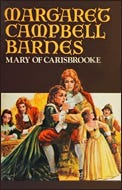Mary of Carisbrooke is about the seventeen-year-old daughter of the sergeant in charge of the small military garrison at Carisbrooke Castle on the Isle of Wight when the doomed King Charles I was confined there in 1647. The king made several attempts to escape from Carisbrooke, and the novel imagines Mary as one of a secret band of royalists plotting to help him. A quiet love story weaves through this sentimental tale of royalty, its loyal supporters, and the dastardly Cromwellians who would pull all down.
Mary is courteous, kind, conscientious and sensible. As the story begins, she is trying to help a pregnant housemaid retain her position. When the king comes to Carisbrooke hoping for shelter but landing in honorable captivity instead, Mary is awestruck to find herself living under the same roof as royalty. Eventually, after joining the supporters planning his escape, she is able to offer the king her characteristic kindness in person. More important to her even than the king, though, are a handsome young royalist, "tall and slender and almost red-headed," whose laughter brightens her days, and a hypocritical Cromwellian officer who threatens her when she refuses his advances.
Mary is a gentle girl, Charles is a gentle king, and Mary of Carisbrooke unfolds at a gentle, unhurried pace that suggests nostalgia for an era when kings deserved and were treated with deep reverence. Parliament's ferocity with the king (kept strictly offstage) intensifies the lingering reverence by contrast. In the end, Charles seems gilded by light: "A shaft of sunlight from one of the windows" falls upon his "proud quietness," and "the divine right in which he believes so strongly seemed to ring him about with light." Readers may be forgiven for wondering whether such an innocent time ever existed, but may nevertheless find the dream a pleasant one. (1956, new Sourcebooks edition 2011; 331 pages, including a Bibliography)




